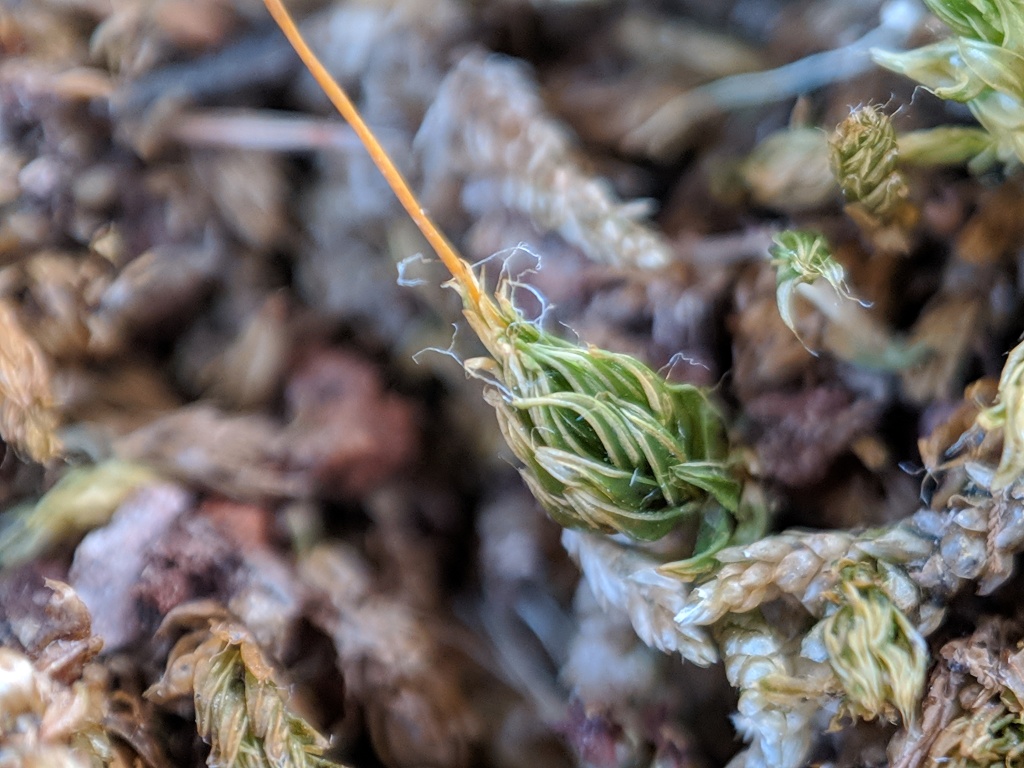Leptostomataceae
Dioicous. Asexual propagules absent. Cushions with cork-like consistency on trees or rarely rocks. Stems erect, simple or forked, tomentose with dark brown or ferrugineous rhizoids matting stem together; central strand present. Leaves arranged around stem and facing all direct directions, monomorphic, oblong-elliptic to ovate, erect-spreading when moist, erect and twisted around stem or scarcely altered when dry; apex broadly rounded to emarginate or broadly acute, with a hairpoint; costa excurrent or rarely subpercurrent; margins entire or rarely somewhat serrulate near apex, reflexed or revolute, without a border; laminal cells subquadrate or rounded-hexagonal, isodiametric or nearly so, becoming rectangular toward base, smooth; alar cells not differentiated. Acrocarpous. Capsule erect or inclined, straight or curved, exserted, operculate; annulus absent or represented by one or two rows of quadrate cells. Calyptra cucullate, smooth, glabrous. Operculum short-conic or convex. Peristome rudimentary, brilliant white, usually reduced to a membrane representing the endostome, sometimes with separate rudimentary exostome teeth or with both exostome and endostome rudimentary and adnate; cilia absent.
Monotypic family that occurs in Sri Lanka, Malesia, Australia, New Zealand, the Society Islands, Juan Fernández Islands, Argentina, and Chile, and comprises eight species (Hyvönen 1987; Crum 1992; Ramsay 2006); two species in Victoria.
The Leptostomataceae is most closely related to the Bryaceae (e.g. Cox & Hedderson 1999; Cox et al. 2000; Bell et al. 2007) and can be distinguished from this family by a combination of the isodiametric laminal cells away from the leaf base, reduced peristomes, and the absence of a large revoluble annulus (Crum 1992).
 Spinning
SpinningCox, C.J.; Goffinet, B.; Newton, A.E.; Shaw, A.J.; Hedderson, T.A.G (2000). Phylogenetic relationships among the diplolepideous-alternate mosses (Bryidae) inferred from nuclear and chloroplast DNA sequences. The Bryologist 103: 224–241.
Cox, C.J.; Hedderson, T.A.J. (1999). Phylogenetic relationships among the ciliate arthrodontous mosses: evidence from chloroplast and nuclear DNA sequences. *Plant Systematics and Evolution * 215: 119–139.
Crum, H. (1992). A reconsideration of the Leptostomataceae. Journal of the Hattori Botanical Laboratory 72: 127–139.
Hyvönen, J. (1987). A synopsis of genus Leptostomum (Leptostomataceae, Musci). Annales Botanici Fennici 24: 63–72.
Ramsay, H.P. (2006). Leptostomataceae, in McCarthy, P.M. (ed.), Flora of Australia. Vol. 51 Mosses 1, pp. 349–353. ABRS, Canberra.

